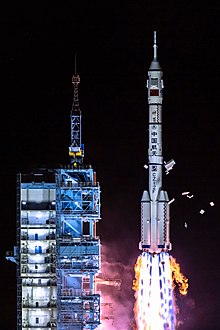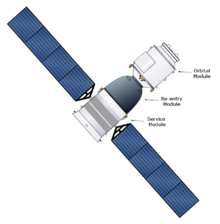cosmos.wikisort.org - Spacecraft
Shenzhou 13 (Chinese: 神舟十三号; pinyin: Shénzhōu Shísān-hào; lit. 'Divine Boat Number 13') was a Chinese spaceflight launched on 15 October 2021 at 16:23 UTC. The flight marked the eighth crewed Chinese spaceflight and the thirteenth flight of the Shenzhou program. The spacecraft carried three People's Liberation Army Astronaut Corps (PLAAC) taikonauts on the second flight to the Tianhe core module, the first module of the Tiangong space station.[3] The launch of the three-person crew with a Long March-2F launch vehicle took place from the Jiuquan Satellite Launch Center.
 Roll out of Shenzhou 13 | |
| Mission type | Tiangong Space Station crew transport |
|---|---|
| Operator | China Manned Space Agency |
| COSPAR ID | 2021-092A |
| SATCAT no. | 49326 |
| Mission duration | 182 days, 9 hours and 32 minutes |
| Spacecraft properties | |
| Spacecraft | Shenzhou 13 |
| Spacecraft type | Shenzhou |
| Manufacturer | China Aerospace Science and Technology Corporation |
| Crew | |
| Crew size | 3 |
| Members | Zhai Zhigang Wang Yaping Ye Guangfu |
| EVAs | 2 |
| EVA duration | 12 hours 36 minutes[1] |
| Start of mission | |
| Launch date | 15 October 2021, 16:23:56 UTC[2] |
| Rocket | Long March 2F |
| Launch site | Jiuquan, LA-4/SLS |
| Contractor | China Academy of Launch Vehicle Technology |
| End of mission | |
| Landing date | 16 April 2022, 01:56:49 UTC |
| Landing site | Inner Mongolia, China |
| Orbital parameters | |
| Reference system | Geocentric orbit |
| Regime | Low Earth orbit |
| Inclination | 41.5° |
| Docking with Tiangong Space Station | |
| Docking port | Tianhe Nadir |
| Docking date | 15 October 2021, 22:56 UTC |
| Undocking date | 15 April 2022, 16:44 UTC |
| Time docked | 181 days, 17 hours and 48 minutes |
 Shenzhou 13 mission patch  Ye Guangfu, Zhai Zhigang and Wang Yaping Shenzhou programme Tiangong program | |
Shenzhou 13 successfully undocked from the Tianhe core module on 15 April 2022 at 16:44 UTC and subsequently performed a series of fast return de-orbit procedures which would enable the spacecraft to touchdown in nine hours.[4][2] The reentry module returned to Earth on 16 April 2022.[5] At 182 days, the mission set a new national human spaceflight duration record, surpassing Shenzhou 12's 92 days.[6]
Background
The spaceflight is the first of the upcoming missions set to last six months (180 days).[7] After that, the six-month stay aboard the space station will become the normal duration of the astronaut crew in orbit.[8] The flight marks the second of four crewed missions scheduled to dock with the Tiangong space station by the end of construction in 2022.[9]
Mission

The spacecraft was launched on a Long March-2F launch vehicle in Jiuquan Satellite Launch Center in China's Gobi Desert on 15 October 2021, at 16:23:56 UTC.[10] After about six-and-a-half hours flight it arrived at Chinese space station Tiangong. The mission docked with the Tianhe core module at 22:56 UTC, on 15 October 2021, following the launch and successful docking of Tianzhou 3 on 20 September 2021, the third flight of China's Tianzhou cargo resupply craft.[citation needed]
The crew entered the Tianhe core module later on 16 October 2021, at 01:58 UTC as the second expedition to the Tiangong space station.[11]
At least two spacewalks are planned to occur during the crew's approximately six-month stay in orbit. Shenzhou 14 will be in standby for any possible rescue mission.[12]
Spacewalks
On 7 November 2021, the first planned spacewalk was carried out by Zhai Zhigang and Wang Yaping as they left the Tianhe core module to conduct extravehicular activities. Wang made history by becoming the first Chinese woman to carry out a spacewalk. They were tasked with conducting the installation of the robotic arm suspension and the adapter and also to do typical tests of equipment. The spacewalk lasted for 6 hours and 25 minutes.[13]
On 26 December 2021, Ye Guangfu and Zhai Zhigang conducted the second planned spacewalk with Wang Yaping assisting the pair from inside the Tianhe module. Ye and Zhai's tasks included deploying an external "panoramic camera C", installing a foot restraint platform and testing various methods of moving objects outside the station. The spacewalk lasted 6 hours and 11 minutes.[14]
Spacecraft

Shenzhou 13 spacecraft is based heavily on Soyuz MS technology. Shenzhou was approved in 1992 as part of the Chinese space program Project 921, and has a design similar to the Russian Soyuz spacecraft.[citation needed]
In the front of the spacecraft, there is the orbital module which contains an androgynous docking ring based on APAS technology, which is used to dock to the Tianhe core module. In the middle is the reentry module containing the crew which is a scaled-up version of the Soyuz descent module. The rear of the spacecraft is the service module which is equipped with engines, fuel tanks, and solar panels.[15]
The China Academy of Space Technology developed a new technology on Shenzhou 13 for the purpose of radial docking to the bottom of Tianhe, requiring maintenance of continuous altitude and orbit control. This type of docking differed from the front and rear dockings used by the previous Shenzhou 12 as well as Tianzhou 2 and 3 missions, creating a logistic chain of space infrastructure that includes the core module, manned and the cargo spacecraft.[16]
Crew

The crew was publicly announced in a press conference on 14 October 2021.[17]
PLASSF Major General Zhai Zhigang is a veteran of Shenzhou 7. Senior Colonel Wang Yaping, who became the first woman to visit the Tiangong Space Station, previously flew on Shenzhou 10. Senior Colonel Ye Guangfu makes his first flight to space.[17] When Shenzhou 13 completed the 180-day mission, Wang had spent about 197 days in space, setting a new record for a Chinese astronaut.
| Position | Crew member | |
|---|---|---|
| Commander | Second spaceflight | |
| Operator | Second spaceflight | |
| System Operator | First spaceflight | |
Space lectures
On 9 December 2021 at 3:55 p.m. Beijing time (7:55 a.m. UTC), the three crew members held a lesson and conducted the scientific experiments from space, as they did in 2013 at Shenzhou 10, to educate, motivate and inspire Chinese younger generation in science and technology for the long term development of the nation. The "main classroom" was in the China Science and Technology Museum in Beijing, and "branch classrooms" were in Nanning, Guangxi Province, Wenchuan, Sichuan Province - where Wang Yaping had flown relief supplies to the earthquake area there in 2008 - Hong Kong and Macau. Wang Yaping conducted the scientific experiments and taught a science lesson to Chinese students by live television broadcast. After a brief presentation of their everyday life and a scientific experiment on cell biology, the crew members performed experiments suitable for high school students on the behaviour of effervescent tablets in weightlessness, the surface tension of water, etc., followed by the opportunity to answer schoolchildren's questions from the classrooms. [18][19]
On 23 March 2022 at 3:40 p.m. Beijing time (7:40 a.m. UTC), the three crew members held a second lesson and conducted extra scientific experiments from space as like the previous time. The "main classroom" was in the China Science and Technology Museum in Beijing, with two more "branch classrooms" were in Lhasa, Tibet Autonomous Region and Ürümqi, Xinjiang Uygur Autonomous Region. All three crew members took turns answering questions raised by the schoolchildren after the lecture session was over.[20]
Interaction with American students
On 10 April 2022, at 3:00 a.m. Beijing time (9 April 2022, 7:00 p.m. UTC), a special question and answer (Q&A) session between the three taikonauts and American students was held in the Chinese Embassy in U.S. in Washington, D.C. The event was officially hosted by the Chinese Ambassador to the United States Qin Gang. Elon Musk was also featured in the event where his pre-recorded remarks on wishes of cooperation of humanity on space in the future was played.[21]
Aftermath
The follow-up Tianzhou 4 unmanned cargo resupply mission is planned for launch sometime on 10 May 2022 for the upcoming Shenzhou 14 mission.[22]
The landing of the Shenzhou 13 crew took place at the Dongfeng landing site in north China's Inner Mongolia Autonomous Region on 16 April 2022.[4][23] A comprehensive evaluation of the two missions Shenzhou 12 and Shenzhou 13 will then take place. If necessary, the approval for the further expansion of the space station with the two science Laboratory Cabin Module Wentian and Mengtian will be granted.[citation needed]
References
- "Tiangong: Expedition 2". 27 December 2021. Retrieved 8 November 2021.
- "神舟十三号定于周六0时23分发射 新"太空出差三人组"包括一位女航天员". cn.reuters.com.
- Barbosa, Rui C. (1 March 2021). "China preparing to build Tiangong station in 2021, complete by 2022". NASASpaceFlight.com. Retrieved 1 March 2021.
- @CNSpaceflight (12 April 2022). "Jiuquan Satellite Launch Center conducted the last dress rehearsal of #Shenzhou13 recovery. According to the post in Wechat, the landing target is in the east area of Dongfeng Landing Site, same as Shenzhou-12, at ~09:10 local time on APR.16" (Tweet) – via Twitter.
- "Watch China's Shenzhou 13 astronauts return to Earth from space station tonight". Space.com. Retrieved 16 April 2022.
- "China's Shenzhou 13 capsule lands with crew of 3 after record-setting mission". Space.com. Retrieved 16 April 2022.
- "中国航天进入空间站建造关键时期——访中国载人航天工程办公室主任郝淳". xinhuanet.com. Retrieved 29 April 2021.
- "空间站建造后续有四次载人飞行,航天员每次在轨驻留3至6个月". thepaper.cn. Retrieved 29 April 2021.
- Barbosa, Rui C. (1 March 2021). "China preparing to build Tiangong station in 2021, complete by 2022". NASASpaceFlight.com. Retrieved 1 March 2021.
- "China launches Shenzhou 13 astronauts on historic mission to new space station". space.com. Retrieved 15 October 2021.
- "神舟十三号3名航天员顺利进驻天和核心舱". xinhua.news. Retrieved 16 October 2021.
- "China's Shenzhou 14 is on standby to launch in case of space station emergency". Space.com. 22 October 2021. Retrieved 25 October 2021.
- "China's Shenzhou-13 taikonauts complete first extravehicular mission". Xinhua News. 7 November 2021. Retrieved 7 November 2021.
- Davenport, Justin (26 December 2021). "Shenzhou-13 crew conducts second spacewalk of mission". NASASpaceFlight.com. Retrieved 26 December 2021.
- "China's Shenzhou 13 crew docks with space station for 6-month stay". South China Morning Post. Retrieved 16 October 2021.
- "China's Shenzhou 13 Mission and Its Long-Term Impact". The Diplomat. Retrieved 20 October 2021.
- "China unveils Shenzhou-13 crew for six-month space station mission".
- 张馨方 (6 December 2021). ""天宫课堂"第一课定于12月9日下午在中国空间站开讲,此次太空授课活动将进行全程现场直播". Mp.weixin.qq.com (in Chinese).
- Live: Special coverage of first class from China's space station on YouTube
- Tiangong (China Space Station) is going Live 直播中国空间站视角下的地球 on YouTube
- "Elon Musk featured in Chinese embassy event focused on space exploration". South China Morning Post. Retrieved 11 April 2022.
- @CNSpaceflight (15 March 2022). "According to a travel agency, Long March 7 Y5 will launch #Tianzhou4 on MAY.10" (Tweet) – via Twitter.
- Wall, Mike (16 April 2022). "China's Shenzhou 13 capsule lands with crew of 3 after record-setting mission". Space.com. Retrieved 16 April 2022.
На других языках
- [en] Shenzhou 13
[es] Shenzhou 13
Shenzhou 13 fue un vuelo espacial tripulado lanzado el 15 de octubre de 2021 que forma parte del Programa Shenzhou, siendo el octavo vuelo tripulado de este programa y el segundo a la CSS.[1] La nave transportó a tres taikonautas de la CNSA al módulo Tianhe, el módulo principal de la estación espacial china.[2][ru] Шэньчжоу-13
Шэньчжоу-13 (кит. трад. 神舟十三号, пиньинь Shénzhōu shísān hào, палл. Шэньчжоу шисань хао, буквально: «Священный челн-13», англ. Shenzhou-13) — восьмой пилотируемый космический корабль КНР серии «Шэньчжоу». Запуск состоялся 15 октября 2021 года с тремя космонавтами на борту.Другой контент может иметь иную лицензию. Перед использованием материалов сайта WikiSort.org внимательно изучите правила лицензирования конкретных элементов наполнения сайта.
WikiSort.org - проект по пересортировке и дополнению контента Википедии